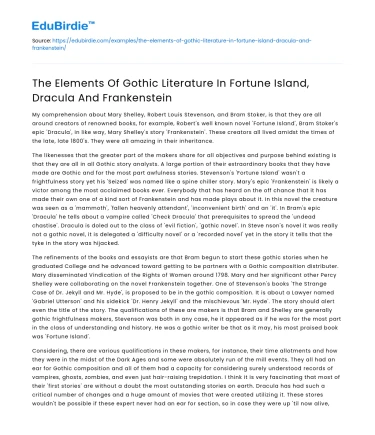Introduction
Gothic literature, a genre marked by its exploration of the macabre and mysterious, has captivated readers for centuries. With its roots in the late 18th century, Gothic literature has evolved to encompass a wide range of themes and settings. This essay explores the unique manifestations of Gothic literature in three seminal works: "Fortune Island," "Dracula" by Bram Stoker, and "Frankenstein" by Mary Shelley. Each of these works exemplifies different aspects of the Gothic tradition, from the eerie isolation of Fortune Island to the supernatural horror of Dracula and the existential dread in Frankenstein. By examining these texts, this essay aims to highlight how Gothic literature reflects societal fears and philosophical inquiries, adapting its themes to suit different historical and cultural contexts.
Gothic Elements in Fortune Island
"Fortune Island," though less renowned than "Dracula" or "Frankenstein," offers a unique contribution to Gothic literature. Set on a remote island, the narrative capitalizes on isolation and the unknown, two quintessential elements of Gothic fiction. The island itself becomes a character, shrouded in mystery and danger. As the protagonist navigates its treacherous landscape, readers are confronted with themes of madness and the supernatural, echoing the works of earlier Gothic authors who utilized similar settings to evoke fear and curiosity. In "Fortune Island," the Gothic atmosphere is intensified by the island's unpredictable weather and its eerie silence, contributing to a sense of foreboding and suspense. The use of the island as a microcosm for human fears and desires allows the narrative to delve into psychological complexities, reflecting the Gothic tradition's emphasis on exploring the darker aspects of the human psyche.
Save your time!
We can take care of your essay
- Proper editing and formatting
- Free revision, title page, and bibliography
- Flexible prices and money-back guarantee
Transitioning from the isolated landscapes of "Fortune Island," we delve into the supernatural horror of Bram Stoker's "Dracula." While both works embrace isolation, "Dracula" expands the Gothic narrative to explore the clash between ancient evil and modernity. This exploration is central to understanding how Gothic literature adapts to reflect contemporary fears and values.
The Supernatural and Modernity in Dracula
Bram Stoker's "Dracula" is a cornerstone of Gothic literature, renowned for its depiction of the supernatural intertwined with the anxieties of the modern world. The novel presents Count Dracula as the embodiment of ancient, supernatural evil invading the civilized world, a theme that resonates with the Victorian era's fear of the unknown and the foreign. Stoker's use of epistolary narrative style enhances the Gothic atmosphere, allowing readers to experience the characters' dread and suspense firsthand. The contrast between Dracula's old-world mysticism and the protagonists' use of modern technology, such as telegrams and typewriters, underscores the tension between tradition and progress. This tension is a hallmark of Gothic literature, reflecting societal fears of change and the loss of cultural identity. Moreover, "Dracula" explores themes of sexuality and power, with the vampire serving as a metaphor for forbidden desires and the subversion of social norms. In doing so, Stoker's work continues the Gothic tradition of using horror to probe the complexities of human nature and societal constructs.
As we transition to Mary Shelley's "Frankenstein," the focus shifts from the supernatural to the scientific, highlighting another dimension of Gothic literature's adaptability. While "Dracula" explores the fear of ancient evil, "Frankenstein" delves into the terror of uncontrolled scientific ambition, reflecting the Romantic era's cautionary stance on the limits of human knowledge.
Science and Existential Horror in Frankenstein
Mary Shelley's "Frankenstein" is a seminal work in Gothic literature, distinguished by its exploration of the consequences of unchecked scientific ambition. The novel centers around Victor Frankenstein, a scientist who defies natural laws to create life, only to be haunted by his monstrous creation. This narrative explores the Gothic theme of the sublime, where the awe of scientific discovery is intertwined with terror and moral ambiguity. Shelley's portrayal of the creature, often referred to as "the monster," challenges readers to consider themes of alienation, identity, and the ethical implications of scientific progress. The novel's setting, from the icy wastelands of the Arctic to the desolate Swiss Alps, enhances the atmosphere of existential dread, emphasizing the isolation of both creator and creation. "Frankenstein" reflects the Gothic tradition's preoccupation with the limits of human knowledge and the potential for hubris. As a response to the Enlightenment's emphasis on reason and progress, Shelley's work serves as a cautionary tale about the dangers of overreaching ambition and the ethical responsibilities of scientific discovery.
Conclusion
In conclusion, Gothic literature's enduring appeal lies in its ability to adapt to different cultural and historical contexts, reflecting societal fears and philosophical inquiries. "Fortune Island," "Dracula," and "Frankenstein" each exemplify distinct aspects of the Gothic tradition, from the eerie isolation and psychological depth of "Fortune Island" to the supernatural horror and modern anxieties of "Dracula," and the existential and ethical concerns in "Frankenstein." By examining these works, we gain insight into the genre's versatility and its capacity to probe the darker aspects of human nature and society. As the genre continues to evolve, Gothic literature remains a powerful vehicle for exploring the complexities of the human experience, challenging readers to confront their fears and question their assumptions about the world.






 Stuck on your essay?
Stuck on your essay?

